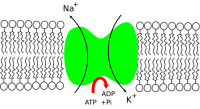
Photo from wikipedia
Bronchopulmonary dysplasia (BPD) affects 20% of very preterm infants born Click to show full abstract
Bronchopulmonary dysplasia (BPD) affects 20% of very preterm infants born <33 weeks gestational age (GA). In this subgroup of neonates, postnatal fluid adaptation may be inefficient due to kidney immaturity, resulting in increased pulmonary interstitial fluid content, lung damage and impaired air-gas exchange. Early postnatal fluid status might contribute to the risk of developing BPD and requires further investigation. To investigate the association of three indicators of early postnatal fluid status (median serum sodium concentration, cumulative fluid balance and maximum percentage weight loss) measured over the first 10 days after delivery with death and/or BPD in infants born <33 weeks. This retrospective cohort study included infants born 23-32 weeks GA, admitted to the Montreal Children’s Hospital’s NICU from 2015-2018. Neonates moribund on admission, with any major congenital malformation and/or admitted to the NICU >1 day after birth were excluded. Data was collected from the Canadian Neonatal Network database and individual chart review. BPD was defined as oxygen therapy or respiratory support at 36 weeks’ corrected GA. Unadjusted comparisons were made using the Wilcoxon test. Associations between exposures (median serum sodium concentration, cumulative fluid balance and maximum percentage weight loss in the first 10 days after delivery) and outcomes (death and/or BPD) were assessed using multivariable logistic regression analyses adjusting for sex, steroid use, GA, small-for-gestational-age status, Apgar at 5 min<7, surfactant use and mode of delivery. Among 439 eligible infants, 125 died and/or developed BPD (29%). Median serum sodium concentration was 139 mmol/L (IQR 136-141) among BPD-free survivors and 136 mmol/L (IQR 134-139) among infants with death and/or BPD (p<0.001). Cumulative fluid balance was 4.09 dL/kg (IQR 2.98-4.78) among BPD-free survivors and 4.88 dL/kg (IQR 3.96-5.95) among infants with death and/or BPD (p<0.001). Maximum percentage weight loss was 8.5% (IQR 5.4-11.6) among BPD-free survivors and 9.2% (IQR 4.9-12.9) among infants with death and/or BPD (p=0.41). Adjusted odds ratios (95% confidence interval) are presented in Table 1. Among very preterm infants, higher cumulative fluid balance in the first 10 days after delivery is associated with higher odds of death and/or BPD. Thus, targeting lower cumulative fluid balance may improve BPD-free survival.
Journal Title: Paediatrics and Child Health
Year Published: 2020
Link to full text (if available)
Share on Social Media: Sign Up to like & get
recommendations!